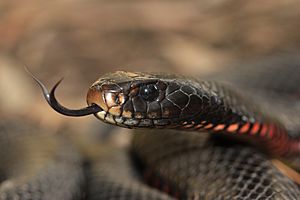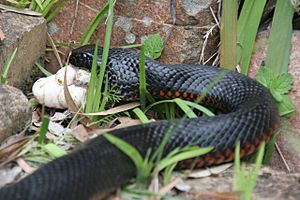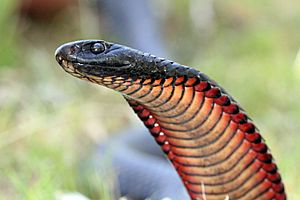Red-bellied black snake facts for kids
Quick facts for kids Red-Bellied Black Snake |
|
|---|---|
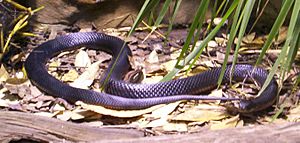 |
|
| Red-bellied Black Snake at Brisbane Forest Park, Brisbane, Queensland, Australia |
|
| Scientific classification | |
| Kingdom: | |
| Phylum: | |
| Class: | |
| Order: | |
| Suborder: | |
| Family: | |
| Genus: |
Pseudechis
|
| Species: |
P. porphyriacus
|
| Binomial name | |
| Pseudechis porphyriacus Shaw, 1794
|
|
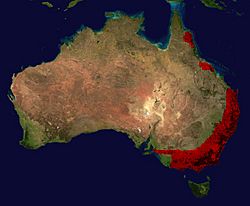 |
|
| Range of Red-Bellied Black Snake (in red) | |
The red-bellied black snake (Pseudechis porphyriacus) is a type of venomous snake found only in Australia. It is one of the most common snakes seen in eastern Australia.
These snakes are usually about 1.25 meters (4 feet) long. They have shiny black backs, bright red or orange sides, and a pink or dull red belly.
Red-bellied black snakes are not usually aggressive. They often try to get away from people. But if they feel threatened, they can bite. While their venom can make you quite sick, no one has ever died from a bite. Their venom is not as strong as some other Australian snakes.
You can often find them in forests, woodlands, and swampy areas. They sometimes even visit nearby towns and cities. They like to hunt in shallow water among plants and logs. Their favorite food is frogs, but they also eat fish, other reptiles, and small mammals.
Contents
What Does It Look Like?
The red-bellied black snake has a shiny black body. Its snout (nose area) is a lighter grey, and its mouth is brown. Its tail is completely black. It doesn't have a clear neck; its head blends smoothly into its body.
The sides of the snake are bright red or orange. This color fades to pink or dull red on its belly.
Most red-bellied black snakes are about 1.25 meters (4 feet) long. The longest one ever found was 2.55 meters (8.4 feet) long! Male snakes are usually a bit bigger than females.
Some people who study snakes say that red-bellied black snakes can have a strong smell. This smell can help them find the snakes in the wild.
Like all snakes in its family (called elapids), it has fangs at the front of its mouth.
Where Do They Live?
The red-bellied black snake lives along the east coast of Australia. It is one of the snakes you are most likely to see there. You can find them in cities like Sydney, Brisbane, Melbourne, and Adelaide. They also live in forests, woodlands, and bushland areas.
These snakes are most often seen near water, like dams, streams, and ponds. They can sometimes travel up to 100 meters (330 feet) away from water, even into people's backyards. They especially like shallow water with lots of plants, logs, or other things to hide in.
How Do They Behave?
Red-bellied black snakes can hide in many places. They might be in logs, old animal burrows, or clumps of grass. They can also escape into water and hide there. One snake was even reported to stay underwater for 23 minutes! When they swim, they might keep their whole head or just their nostrils above the water. Sometimes, they float still on the water, looking like a stick.
These snakes seem to have areas or territories they know well. They usually stay within these areas. They might even have favorite hiding spots within their territory.
The red-bellied black snake is usually not aggressive. It will typically try to get away if someone comes near. If it feels very threatened, it might get ready to strike. It will lift its head and the front part of its body off the ground. It also flattens its neck to look bigger. It will only bite as a last choice. They are usually active during the day. However, sometimes they are seen moving around at night. When they are not hunting or warming up in the sun, they might hide under wood, rocks, or in holes.
Snakes are most active when their body temperature is between 28 and 31 degrees Celsius (82 and 88 degrees Fahrenheit). They warm up by lying in sunny spots in the cool morning. On hot days, they rest in the shade. They might move less during hot, dry weather in late summer and autumn.
Instead of truly hibernating, red-bellied black snakes become less active in winter. They hide in sheltered spots but might come out on warm, sunny days. Their dark color helps them soak up heat from the sun faster.
Reproduction and Life Cycle
In spring, male red-bellied black snakes often fight each other. These fights can last from 2 to 30 minutes. They even attack other males that are already mating with females. They wrestle strongly but rarely bite. They also have head-pushing contests, trying to push the other snake's head down.
A male snake will look for a female and rub his chin on her body. He might twitch, hiss, and sometimes even bite gently.
Female snakes can become pregnant from early spring to late summer. Pregnant females become much less active. They often gather in small groups and share the same hiding spot. They also bask in the sun together.
Red-bellied black snakes give birth to live babies. The babies are born in individual thin sacs after about 14 weeks of pregnancy. This usually happens in February or March.
A female can have between eight and 40 babies at a time. The young snakes are about 12.2 centimeters (4.8 inches) long when they are born. They come out of their sacs very soon after birth. In their first year, young snakes almost triple their length. They also become 18 times heavier! Males can start breeding at about 31 months old, and females a little earlier.
Red-bellied black snakes can live for up to 25 years.
What Do They Eat?
Red-bellied black snakes mainly eat frogs. But they also hunt other reptiles and small mammals. They even eat other snakes, including their own kind! They hunt fish in the water. They can hunt on or under the water's surface. They might eat their prey underwater or bring it to the surface. Some have been seen stirring up the mud, perhaps to make prey move.
As red-bellied black snakes grow, they keep eating the same size prey. But they also start to eat bigger animals. Even though they prefer live food, some have been seen eating frogs that were squashed by cars.
Is Their Venom Dangerous?
Early settlers in Australia were afraid of the red-bellied black snake. But it turned out to be much less dangerous than many other snake species. Between 2005 and 2015, it was responsible for 16% of snake bites in Australia where the snake was identified. However, no deaths have ever been recorded from its bite.
Bites from red-bellied black snakes can be very painful. They often need pain medicine. Bites can also cause swelling, bleeding for a long time, and even tissue damage, especially if the bite is on a finger.
This snake is the most common one to bite dogs in New South Wales, Australia.
Protecting Red-Bellied Black Snakes
The red-bellied black snake is considered a "least-concern species" by the International Union for Conservation of Nature. This means it is not currently at risk of disappearing.
Red-Bellied Black Snakes as Pets
The red-bellied black snake is one of the snakes often kept as pets in Australia. They adapt well to living in captivity. They can eat mice, but can also survive on fish, chicken, and even dog food.
Images for kids
See also
 In Spanish: Serpiente negra de vientre rojo para niños
In Spanish: Serpiente negra de vientre rojo para niños


